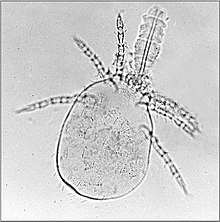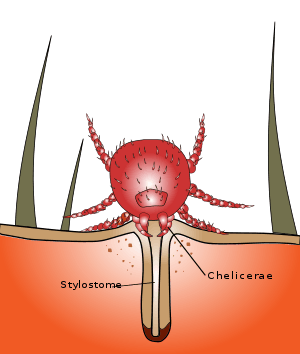Stylostome
The stylostome is a funnel- or channel-like structure formed in response to trombiculid mites. The formation is not caused by the mouthparts of the mites, because these mites do not have needle-like mouthparts as other hematophagous animals have been known to have, but have chelicerae, which only pierce the skin. The tube is formed by the digestive enzymes in the saliva, which are the same salivary secretions that break down cells and cause the surrounding tissue to harden.[1] As the mite feeds longer, the saliva seeps farther down, and digesting more tissue, therefore causes the stylosome to penetrate to lower layers of skin.[2]


Transmission of disease
Normally, the bite mark causes local swelling or welts, but in more serious cases it causes dermatitis. The mite can be infected with a disease called scrub typhus in Asia and the Pacific by carrying saliva directly to the blood stream, but mites in North America have not been known to transmit Lyme disease, Rocky Mountain spotted fever, tularemia or any other disease.
References
- Tally, Steve (2001-07-16). "As chiggers get thicker it's no time to snicker, entomologist says". Purdue University. Retrieved 2019-07-02.
- Ambrose, Kevin (2014-09-14). "Gross: The insanely itchy chigger feasts as summer retreats". The Washington Post. Retrieved 2019-07-02.